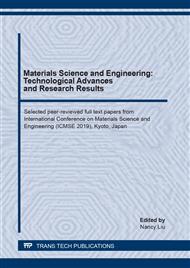p.85
p.93
p.101
p.108
p.116
p.123
p.131
p.141
p.150
Development of Dyeing Process for Sulphatoethylsulphone Reactive-Disperse Dye on Natural and Synthetic Fibers
Abstract:
Sulphatoethylsulphone reactive-disperse dye was synthesized via diazotization reaction of aminophenyl-4-(β-sulphatoethylsulphone) followed by coupling reaction of the diazonium salt with phenol as a coupling agent. The synthesized dye was well dyeable on both natural and synthetic fibers with providing orange shade on cotton, silk and nylon, while the dyed PLA and PET fibers appeared in yellow shade. The dyeing conditions for cotton and silk could be conducted using 60 g/l Na2SO4 and 20 g/l Na2CO3 at 60°C for 90 minutes whereas dyeing on PLA and PET fibers was optimally done at 110°C for 30 and 45 minutes for PLA and PET, respectively. In case of nylon, it could be dyed at 100°C for 15 minutes. The synthesized reactive-disperse dye could well dye on these 5 fibers with excellent color fastness to washing.
Info:
Periodical:
Pages:
116-122
Citation:
Online since:
August 2020
Price:
Сopyright:
© 2020 Trans Tech Publications Ltd. All Rights Reserved
Share:
Citation:


